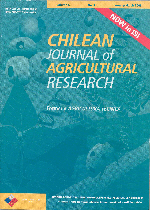
|
Agricultura Técnica
Instituto de Investigaciones Agropecuarias, INIA
ISSN: 0365-2807
EISSN: 0365-2807
Vol. 63, No. 1, 2003, pp. 23-29
|
 Bioline Code: at03004
Bioline Code: at03004
Full paper language: Spanish
Document type: Research Article
Document available free of charge
|
|
|
Agricultura Técnica, Vol. 63, No. 1, 2003, pp. 23-29
| es |
Recria de Terneros a Base de Pastoreo de Tagasaste (Chamaecytisus Proliferus ssp. Palmensis) Suplementados con Avena Grano en la Provincia de Arauco, Chile
Klee, Germán G.; Ovalle, Carlos M. & Canobbi, Juan C. V.
Resumen
El experimento tuvo como objetivo evaluar las variaciones de peso vivo (PV) de terneros en pastoreo otoño - invierno de tagasaste (Chamaecytisus proliferus ssp. palmensis), de cuatro años de edad, 2.500 árboles ha-1, establecido sobre pradera natural, y evaluar el efecto de la suplementación con dos niveles de avena grano (Avena sativa L.). Se utilizaron 18 terneros Holando Europeo x Aberdeen Angus o Hereford, de 184 kg PV y 7,5 meses de edad. Los tratamientos fueron: T1: pastoreo de tagasaste; T2: T1 + 2 kg diarios de avena ternero-1; y T3: T1 + 4 kg diarios de avena ternero-1. Las ganancias diarias de PV fueron significativamente distintas (P < 0,05), y la producciones de PV (kg ha-1), fueron: 0,6; 1,8; y 1,10 kg ternero-1 , y 270; 382; y 529 kg PV ha-1 en los tratamientos T1, T2 y T3, respectivamente. El tagasaste consumible (hojas y tallos tiernos) se estimó en 3,7 kg diarios de MS por ternero. Los componentes de un arbusto correspondieron 25,3% de hojas, 11,3% de tallos tiernos, y 63,4% de tallos leñosos. El promedio de MS total por arbusto alcanzo a 1.983 g, y por ha 4.957 kg . La PT y EM de las hojas fue respectivamente, 21,8% y 2,4 Mcal kg-1, en tallos tiernos 9% y 1,71 Mcal kg-1, y en tallos leñosos 3,4% y 1,9 Mcal kg-1. El tagasaste fue recurso alimenticio invernal aceptable que al ser suplementado con avena grano permitió obtener ganancias de PV significativamente mejores.
Palabras-clave
pastoreo invernal, Avena sativa L., agroforestería
|
| |
| en |
Calf Fattening Based on Tagasaste (Chamaecytisus Proliferus ssp. Palmensis) Grazing and Supplemented by Oats in Arauco Province, Chile
Klee, Germán G.; Ovalle, Carlos M. & Canobbi, Juan C. V.
Abstract
The objective of this experiment was to evaluate the liveweight (LW) gains of calves grazing during the fall-winter season on 4 year-old tagasaste (Chamaecytisus proliferus ssp. palmensis), 2.500 trees per ha, planted on natural pasture, and to evaluate the effect of two levels of oat (Avena sativa L.) grain supplementation. Eighteen Holstein x Aberdeen Angus or Hereford bull calves of 184 kg liveweight and 7.5 months of age were used. The treatments studied were: T1: Tagasaste grazing; T2: Tagasaste grazing plus 2 kg of oats calf-1 day-1; and T3: Tagasaste grazing plus 4 kg of oats calf-1 day-1. The daily LW gain differed significantly (P < 0.05) and was 0.6, 1.8, and 1.10 kg calf-1 and 270, 382 and 529 kg ha-1 in the treatments T1, T2 and T3, respectively. The estimated consumption of tagasaste DM (leaves and soft stems) was 3.7 kg DM bull-calf - 1 day-1. The components of tagasaste plants were 25.3% leaves, 11.3% tender stems and 63.4% woody stems. The mean DM per bush was 1983 g plant-1 and 4,957 kg ha-1. The CP and ME content in leaves were 21.8% and 2.4 Mcal kg-1; in soft stems were 9% and 1.71 Mcal kg-1; in ripe stems 3.4% and 1.9 Mcal kg-1, respectively. Tagasaste was an acceptable resource for winter grazing that on being supplemented with oat grain permitted significantly better liveweight gains.
Keywords
winter grazing, Avena sativa L., agroforestry
|
| |
© Copyright 2003 - Instituto de Investigaciones Agropecuarias, INIA (Chile)
Alternative site location: http://www.inia.cl/at/agritec.htm
|
|
